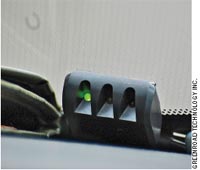The Green Miles
This safe driving device has many benefits, most of which are green.
- By Marc Barrera
- Oct 01, 2008
 Safety is top of mind for many manufacturers, but also growing in importance is the pressure to become “green,” or environmentally sound. GreenRoad Technology Inc., a fairly new driver safety company headquartered in Redwood Shores, Calif., has taken the basic idea of a traffic signal and reengineered it into a small device that gives real-time feedback on 120 driving maneuvers to increase safety. The device is installed on a vehicle’s dash and contains three colored lights -- red for unsafe, yellow for moderately unsafe, and green for safe.
Safety is top of mind for many manufacturers, but also growing in importance is the pressure to become “green,” or environmentally sound. GreenRoad Technology Inc., a fairly new driver safety company headquartered in Redwood Shores, Calif., has taken the basic idea of a traffic signal and reengineered it into a small device that gives real-time feedback on 120 driving maneuvers to increase safety. The device is installed on a vehicle’s dash and contains three colored lights -- red for unsafe, yellow for moderately unsafe, and green for safe.
GreenRoad CEO Dan Steere said even the design of the device took safety into consideration. “The team early on experimented with lots of feedback, and one of the things that became clear was that it was useful to provide real-time feedback, but you have to be careful to make sure that that feedback isn’t distracting to the driver. So there is a balance,” he said. “It’s no more distracting than the little light blinking on your dashboard when you hit your turn signal.”
Recording, Then Feedback
To begin with, GreenRoad will spend a month only recording driver data without providing any feedback, in order to assess drivers’ current risk level. This determination will be cross-referenced with drivers’ history to see whether there is a direct correlation. “When we match up our risk prediction with past accident histories, we can see accurately that red drivers are the most likely to have accidents and their accidents cost the most, yellow less, and green less,” Steere said.
GreenRoad cautions drivers against the fear that its system will track their location or pigeonhole them as unsafe because of one risky maneuver. “We literally ride along as a silent passenger,” Steere said. “We create a profile for each driver that’s driven by every maneuver they’re doing when they’re on the road. It’s not a few isolated events, it’s literally accessing their habits and trends over thousands of maneuvers that they do every week.” Steere described this as a holistic approach that recognizes there are times when a driver must perform an unsafe action to remain safe, such as stopping suddenly if an animal runs out into the road. Although the device does have a GPS receiver, Steere said it is used only to track speed and not to report location. “One of the things we’ve been very careful to architect in our system and communicate very clearly to drivers is the focus of the feedback is how you drive, not where you drive,” he said.
When the device is sending feedback, information is available to both the driver and the employer’s safety manager through the Internet and can be transmitted however the client chooses. “We’ll provide to drivers a weekly e-mail, or it could be a text message,” Steere said. “For each individual driver, the Web application would let them see that over the last week or last month, here’s your risk level. So you’ll start at a very high level, then there are different skill categories beneath that that we summarize the information into.” If they choose, drivers can get more specific and view each individual maneuver for each day, along with information on how to correct poor maneuvers. “By making them aware of the tendencies that they have, most of the population takes that feedback and begins to change the way they drive,” he added.
Armed with the device’s data, safety managers will have the benefit of knowing where individual or group targeted training is needed. According to Steere, with the combination of these different forms of feedback, GreenRoad has seen an average fleet risk decline of 50 percent in a period of three to six months.
Tying in Safety Incentives
To increase its effectiveness, this system also can be tied into a client’s incentive program. During the device’s testing phase, T-Mobile in the United Kingdom used the device in its service vehicles and gave its drivers “Safety Stars” for green maneuvers.
“It’s a point system that customers can choose to use that basically accumulates the equivalent of frequent flyer miles for safe driving,” Steere said.
“As you drive more and more as a green driver, you’ll accumulate points. As a red driver, you don’t accumulate points. Then companies will take this and incorporate it into their overall safety incentive programs to allow drivers to redeem points for vouchers or other types of rewards. It’s an example of how you can provide positive feedback that’s consistent with the rest of the framework.”
During the TMobile trial study, another benefit became clear: fuel economy. Green drivers were shown to achieve fuel efficiency improvements of 7 to 11 percent -- approximately two extra miles per gallon. “In today’s environment where fuel prices are so high, customers have been pretty happy to see that when you improve driving behavior, you basically get a double benefit,” Steere said. “You save a lot of money on accident cost reduction, and you save a lot of money on fuel consumption.”
This article originally appeared in the October 2008 issue of Occupational Health & Safety.